RECOIL OFFGRID Survival Ed Calderon and Ernest Emerson Team Up to Teach Surviving Inside the Killzone
In This Article
Since an early age, we’ve been conditioned to believe that there are clearly identifiable good guys and bad guys. Your first experience with this concept may have been a game of cops and robbers played with your friends, or a fairy tale where the dastardly villain is always out to get the kind-hearted prince. These stereotypes are woven into our psyche, and although as adults we realize them to be an oversimplification of reality, it’s hard not to think of bad guys as irrationally evil. After all, those of us who play by society’s rules struggle to truly understand someone who would rob, rape, murder, or commit other violent acts with no hesitation. But understand them or not, they exist among us. Thankfully Ed Calderon and Ernest Emerson offered a course teaching not only how to know the enemy, but training to get to know ourselves.
Preparing to defend yourself against these predatory individuals means you must be realistic about their actions, their motivations, and even their thought process. They’re not so different from the rest of us. They’re rational and motivated. You might train and practice your defensive skills a few times a month, as permitted by your career; they train and practice daily because victimizing others is their career. And it’s entirely possible that they see you as the villain in their life story — the obstacle impeding them from reaching their goals.
Accepting the reality of a complex adversary is the first step to surviving an encounter with one. As Ed Calderon puts it,
“If you dehumanize the enemy, you become blind to him.”
With this in mind, Calderon drew on his experience working against ruthless cartel members in Mexico and joined forces with renowned knifemaker and combatives instructor Ernest Emerson to offer a two-day class titled “Surviving Inside the Kill Zone.” Rather than ritual-based martial arts skills, this course emphasized reality-based street fighting lessons, and each of these experienced instructors offered a unique take on how you can defend yourself in a hostile environment.
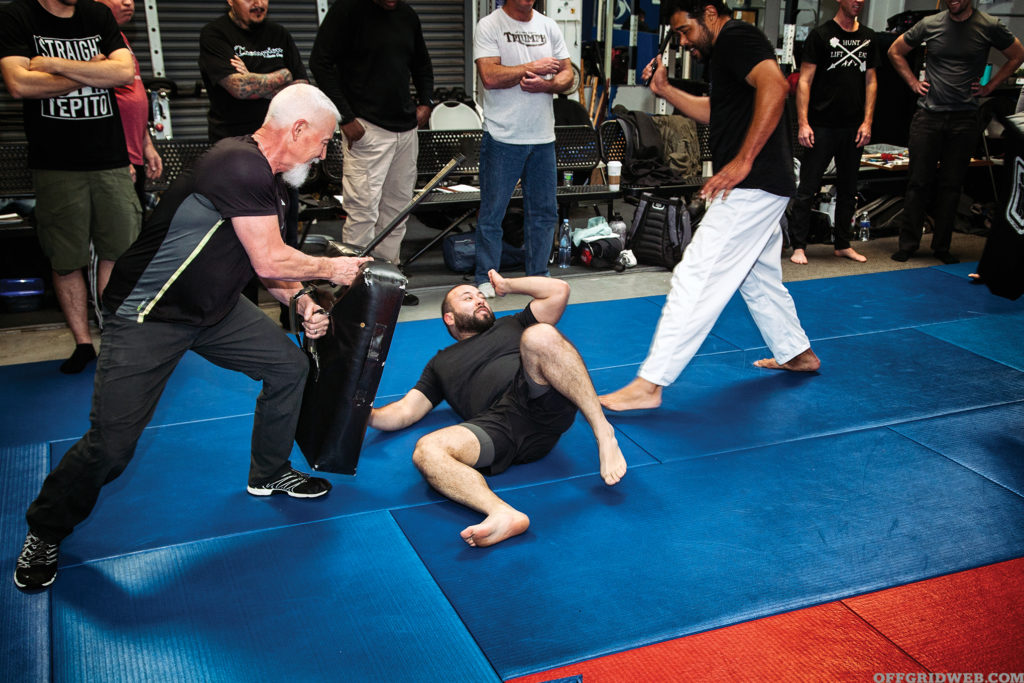
Ed Calderon served as the lead instructor for the first day of the course. Most of his lessons revolved around the concept of the adversarial mindset, and how it should guide your training. Those who have read our previous articles about Calderon’s courses should recall this term —
essentially, it means learning to think like your opponent, so you’ll be better prepared to face him. This is harder than it sounds, especially if you’re attempting to think like a real, multifaceted bad guy instead of the default stereotypes.
“Evil shouldn’t be like the Chupacabra. You shouldn’t be stunned when you see it.”
—Ed Calderon
Calderon broke down his adversarial mindset lessons into a few segments:
One of the first ways to understand the adversary is to look at the tools he may use. As Ed Calderon pointed out, it’s easy for those of us with weapons experience to see photos of street criminals’ equipment and laugh. It’s not uncommon for Mexican cartel members to carry cheap AR-15s with eBay-grade sights — if they bother installing sights at all. A mugger’s definition of concealed carry might be walking around with a beat-up revolver in a jacket pocket. While you’re thinking about zeroing the micro red-dot sight on your Gucci Glock build, your adversary is probably loading his pawn shop pistol with the cheapest ammo he can find and carrying it without a holster. The same can be said of edged weapons — $200 name-brand knives are rare, but $2 fruit knives are common (Calderon calls them “the AK-47 of the knife world”). This also applies to impact weapons, such as knuckle dusters or a lock on a length of cord, and even chemical weapons, such as brake cleaner or roach spray applied to a victim’s face.
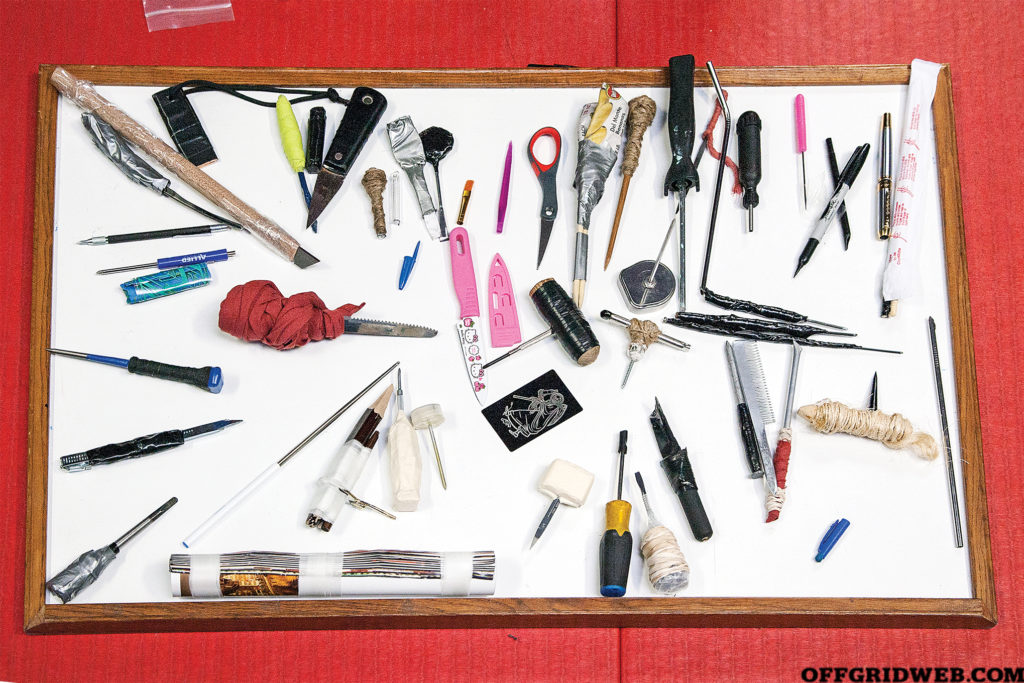
To demonstrate the adversarial mindset, students were instructed to create improvised weapons using household items....
The tools may be crude, but one of the biggest mistakes you can make is to assume the individual wielding them can’t use them with brutal effectiveness. Ed Calderon explained that .22LR is commonly used in murders because it’s cheap, plentiful, and associated with small guns that are easy to conceal. Even if its ballistic performance isn’t on par with larger handgun calibers, it can kill just the same, especially if applied repeatedly at close range.
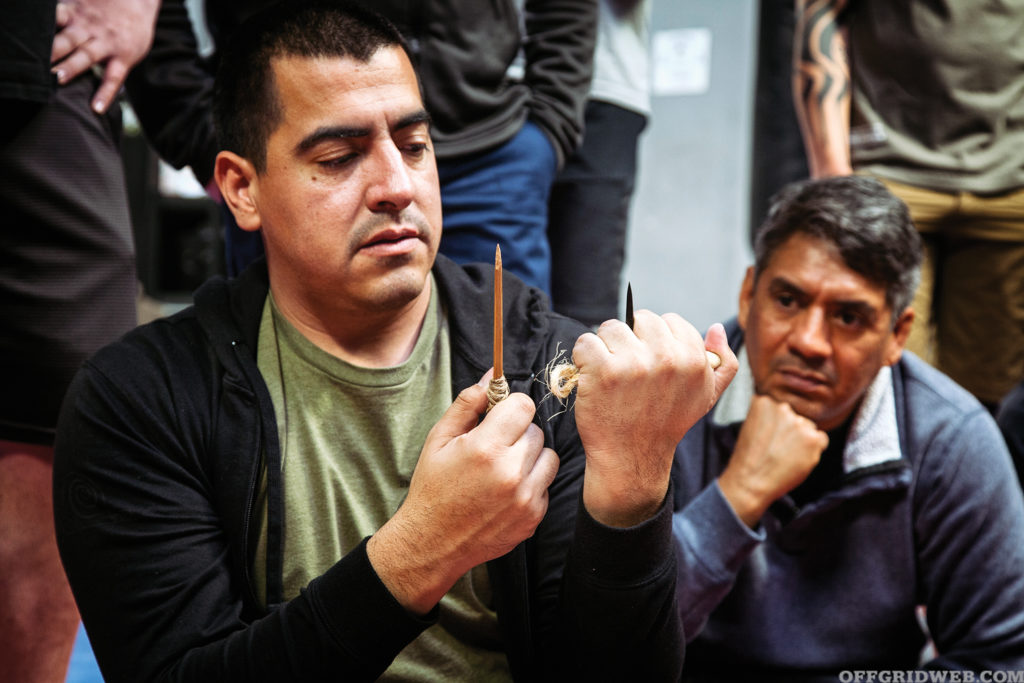
Ed Calderon evaluated the students’ handiwork, discussing criteria such as durability, grip comfort, and penetration...
The ultimate extension of this concept is one of man’s earliest weapons: a pointed stick. It’s deadly and easy to make, just like the improvised shivs you’ll see convicts crafting in prison. To develop a firsthand experience with this primitive yet effective category of tools, students were given a homework assignment to make an improvised shiv from household items in approximately 5 minutes. (You can read the web-exclusive article about the weapon this author made at offgridweb.com/?p=20010.)
Most street criminals have zero formal martial arts training. They build strength and motor skills through work experiences — swinging a hammer at a construction site, chopping food in a kitchen, or slaughtering animals on a farm. They learn tactics by passing along knowledge of successful techniques among their associates or studying videos on the internet. Their software is often just as simple as the hardware mentioned in the previous segment, but that doesn’t make it less effective.
Ed Calderon says we need to anticipate “unrestrained brutality without remorse,” and that the way to prepare yourself for it is through exposure. That means watching the same gory, uncomfortable videos your foes do.
To illustrate the most common techniques, Calderon showed students several clips, including security camera footage of an assassination in a South African restaurant, dashcam footage of a taxi driver being stabbed to death in Mexico, and a particularly stomach-turning video created by ISIS terrorists. The latter was a high-definition, professionally produced instructional film in which the French-speaking narrator set out to teach his overseas brothers how to efficiently murder infidels. He recommended selecting a common, disposable kitchen knife, and showed the ideal weak points to target — the carotid artery in the neck, the subclavian artery under the collarbone, the brachial artery in the armpit, and the femoral artery inside the thigh. Then he calmly turned to a blindfolded and bound prisoner and stabbed and slashed each of these locations as if he were carrying out a classroom demonstration on a mannequin. The victim bled to death on camera as the terrorist instructor continued to speak, completely unfazed. This instantly conveyed Ed Calderon’s message about the existence of remorseless, intelligent evil.
You might ask, why should we be learning techniques used by terrorists and vicious murderers? The answer is simple: It’s virtually impossible to defend against a technique you’ve never witnessed or studied. For the practical application of these lessons, students were given rolled-up pieces of insulation foam with a strip of red tape wrapped around one end. These represented knives — not only are they safer than dull metal or hard rubber for full-intensity sparring, but their spongy texture more accurately represents the feeling of jabbing a blade into flesh. Ed Calderon teaches only three core movements with these simulated blades:
Downward stab to the neck/shoulder
Forward stab to the chest/heart
Upward stab to the groin/lower abdomen
Each of these moves can be augmented in numerous ways. For example, grabbing the opponent by the back of the neck or earlobe to pull them forward, using a forearm to pin them against a wall, or stepping onto their foot and shoving to throw them off-balance. Students paired up and tried each of these methods with the foam weapons, stabbing with full intensity and trading off so both had the opportunity to attack and be attacked. In the end, each realized that avoiding these simple edged weapon attacks is far harder than flashy martial artist YouTube videos make it seem. However, experiencing these techniques allowed students to begin preparing for them.
During the class, Ed Calderon discussed a concept he calls tertia pugna, Latin for the third fight. It separates a violent encounter into three distinct stages:
The First Fight: Battling denial and the “it won’t happen to me” mindset. This requires putting aside feelings of doubt, fear, and apathy that might stop you from taking steps to prepare and train. It’s one of the hardest fights, and one that most people lose. Don’t forget that this isn’t just your fight; it also affects your family and friends. Spread out your knowledge and make them an asset.
The Second Fight: The event itself, an actual fight in which someone tries to victimize you. Trust your gut if something is off, use the skills you’ve developed through training, and if you lose a fight, learn from your failure. The arrows embedded in the back of Ed Calderon’s sneak reaper logo symbolize the past mistakes of a seasoned warrior, which he carries with him and uses to his advantage.
The Third Fight: What happens after. You may need to diagnose yourself and your loved ones for immediate physical injuries (e.g. perform a blood sweep). Some injuries may be less obvious, such as a concussion or TBI. There are also those which are invisible: PTSD, self-doubt, and self-hatred. Know that you may be blamed or criticized for your actions. Accept the fact that you won’t be the same. Don’t bottle up your pain; be willing to talk about it.
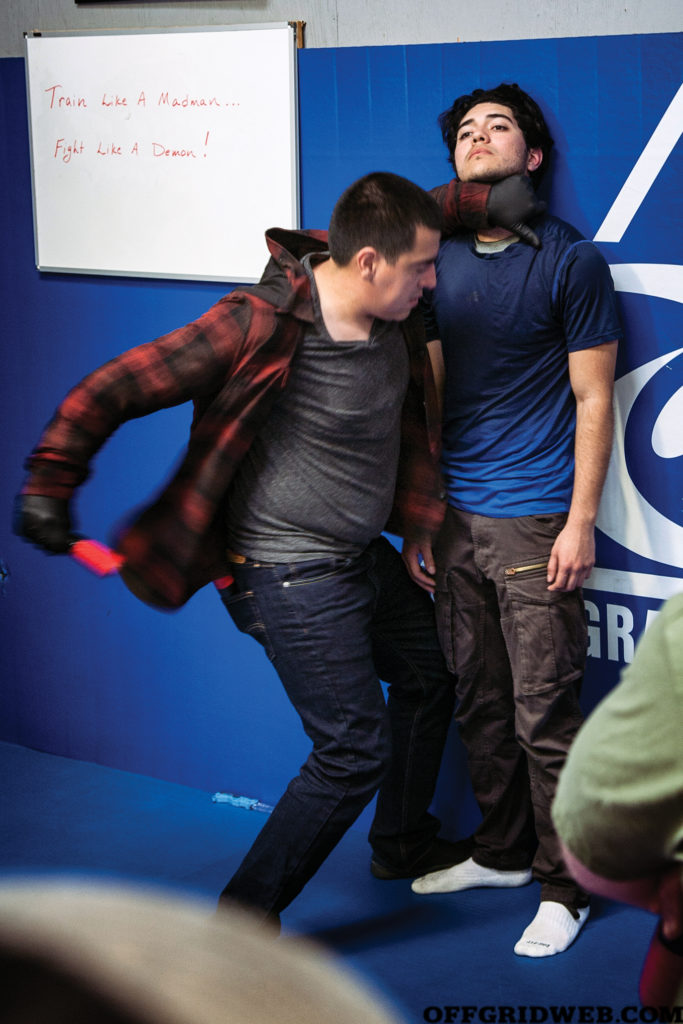
Ed Calderon demonstrates how an aggressor can pin a victim against a wall with his forearm before delivering multiple...
For the second day of the course, Ernest Emerson took the reins as lead instructor. If you’ve shopped for a folding knife in the last 25 years, you’ve almost certainly heard of his company, Emerson Knives, and the tremendous impact it has made on the industry as a whole. But Ernest Emerson is much more than just a knife-maker or edged weapon specialist, and opened Day Two by making that clear. He explained that he’s been studying self-defense skills since long before he began making blades, and Emerson Combat Systems is an extension of his passion for well-rounded training.
“You have far more to fear from a deadly man than a deadly weapon … if you are a fighter, then it does not matter what tool you have in your hand.”
—Ernest Emerson
Emerson covered a wide range of topics from a structured syllabus, ranging from situational awareness and pre-threat indicators to psychological challenges that may arise after using lethal force. However, we gleaned two fundamental lessons from his presentation:
It’s easy to assume that the key to winning a fight is superior strength, but that’s not necessarily the case. There’s a fundamental difference between the skill set of a lumbering strongman who can pull a semitruck and that of a fighter who can throw a lightning-fast, precise knockout blow. Ernest Emerson refers to this difference as “explosive power.”
Awareness and good judgement are necessary to determine when it’s time to fight, but the instant that stimulus is received, your action should be immediate and explosive. Emerson says that your victory relies on three key types of action:
Bias for Action: Think of this as an on-off switch. You must know your criteria for use of force, and when those criteria are met, the switch is flipped. At that point, your default state cannot be to flee, freeze, or contemplate what to do. There should be only one response: fight back.
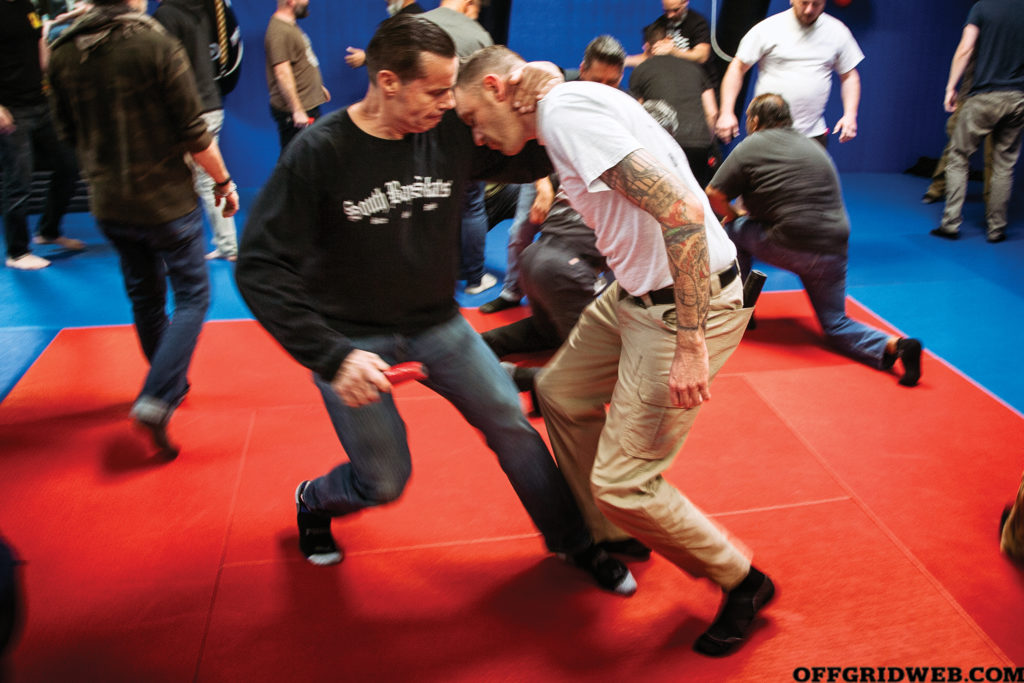
Grabbing the shirt collar, earlobe, or back of the neck with the support hand allows the attacker to pull the victim...
Efficiency of Action: Efficiency is defined as minimizing wasted effort. Ernest Emerson describes the perfect self-
defense technique as fast, simple, and easy to learn and train. It delivers exactly enough energy to end an altercation and leaves its user ready to disengage or follow up with more techniques if necessary.
Violence of Action: “What stops violence? Only a greater force of violence.” If you find yourself in a fight, you must be ready to immediately unbalance, damage, incapacitate, or even kill your opponent. There are obvious legal and moral considerations for each of these actions, but those should be pondered long before a fight begins. When the fight is on, violence is the answer.
Emerson began the practical training segment by teaching students an effective startle response. If a startling or potentially dangerous stimulus occurs, your reflexive response should be to prepare yourself for immediate counterattack. In a defensive situation, you’ll typically be reacting to a foe who acted first by throwing a punch or revealing a weapon. Your best hope of gaining the upper hand is to move quickly and force the opponent to react to you. That equates to instantly shifting your feet into a stable fighting stance, raising your hands to guard your head, dropping your center of gravity, and engaging what Ernest Emerson calls “ferocious resolve” — the will to do whatever is necessary to prevail. Students stood in place and repeatedly practiced the startle response as Emerson called out “threat!”
Developing this startle response might make you feel foolish when there’s a false alarm — Emerson told students that he’s snapped into a startle response a few times when friends or family members surprised him, and had to take a deep breath and laugh it off afterward. But for those who are serious about self-defense, it’s better to appear a little jumpy and endure a few embarrassing moments than to be caught unprepared when an attack occurs. That hand you feel grab your shoulder at a crowded bar might be a friend getting your attention, or it might be a violent drunk lining you up for a sucker punch — it’s better to be ready for the more dangerous option.
“Fatigue makes cowards of us all.” Although Emerson emphasizes that strength isn’t necessarily the decisive factor in a fight, he’s clear about the fact that endurance might be, especially in a real-world setting where first responders may be several minutes away if you’re lucky.
Imagine you’ve just approached your car in a dark parking lot, when a hostile individual steps out of the shadows to confront you. Ideally, you’ll be able to quickly incapacitate him or escape, but what if you can’t? What if the attacker begins grappling with you or pins you against the car? What if additional attackers join in? At this point, the priority may shift from explosive power to endurance. If you want to be hard to kill, Ernest Emerson says you need to have “more gas in the tank” than the opponent. The only way to know how much fuel you’ve got left is through exhaustive training, so buckle down and get ready to sweat.
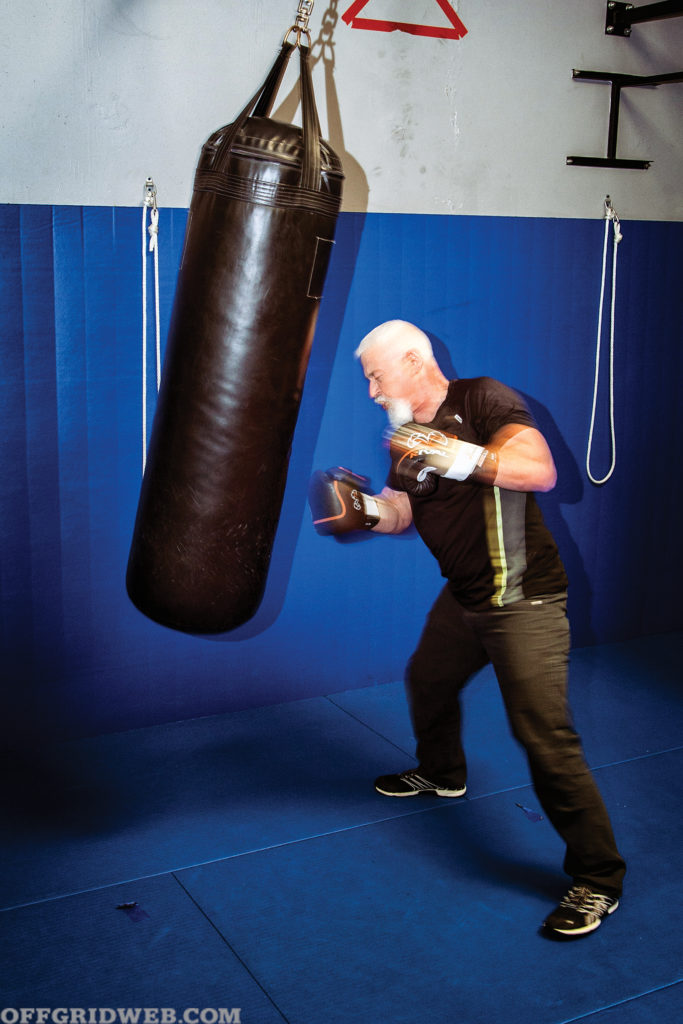
Ernest Emerson demonstrated the All-Out drill by lightly hitting a punching bag as fast as possible for a minute to...
One method Emerson used to test students’ endurance required boxing mitts and a heavy bag. Students stepped up to the bag and were instructed to sidestep around it in a circle, lightly tapping the bag with constant rapid-fire punches for a full minute. This elevates heart rate, but it’s only the beginning of this “All-Out” drill. After a buzzer at the one-minute mark, students had to immediately switch to pummeling the bag as hard as possible for 30 seconds. It left even the most physically fit students breathing hard, and reinforced the lesson that you’ll need substantial energy reserves to finish a fight.
Another drill involved something many fighters would agree is one of the absolute worst-case scenarios: being knocked to the ground and assaulted from various angles by multiple attackers. Each student was told to lie down on their back on the mat, and Ernest Emerson and his assistant instructors used pads and sticks to simulate attacks coming from all sides. This forced the students to keep their guard up to protect their head and neck, observe and deflect incoming blows from the sticks, and simultaneously use their feet to deliver kicks to the pads, pushing the attackers back with all their strength. Some students froze up in a defensive position due to the onslaught; others went entirely on the offensive but struggled to block the attackers’ sticks. As seconds ticked by, each grew tired and overwhelmed.
In the end, the message was clear — the only way to know you’ll be able to keep fighting longer than your opponent is to know you have more endurance than he does.
Emerson Combat Systems is based around 10 core attributes, which were outlined on the course syllabus:
1. Education: Cultivating your knowledge of self-defense skills, threats, and the environment.
2. Situational Awareness: Tactical awareness of your surroundings and anyone who is close enough to cause you harm.
3. Preparation: Training in a realistic manner and building up physical fitness and endurance before a fight.
4. Bias for Action: Immediate response to a threat, as opposed to freezing.
5. Proper Mindset: All defense is offense. Accept violence and know that you will prevail.
6. Ferocious Resolve: Unflinching determination to do whatever is necessary to win the fight.
7. Gut Feel: Trust your gut survival instinct; it only exists to protect you.
8. Faith: In your abilities, your cause, and fighting the good fight.
9. Moral Clarity: Know when you’re in the right and your attacker is in the wrong. His actions caused your actions.
10. Never Quit, Never Give Up, Never Surrender.
The world we live in isn’t always clear-cut, and the adversaries we face aren’t one-dimensional. Criminals and other predatory individuals are often just as motivated and logical as we are. They select techniques with proven effectiveness, and they carefully choose the time and place for a confrontation — it’ll always be one where you have (or at least appear to have) a disadvantage. Expect to be alone and expect to receive little to no warning before an attack.
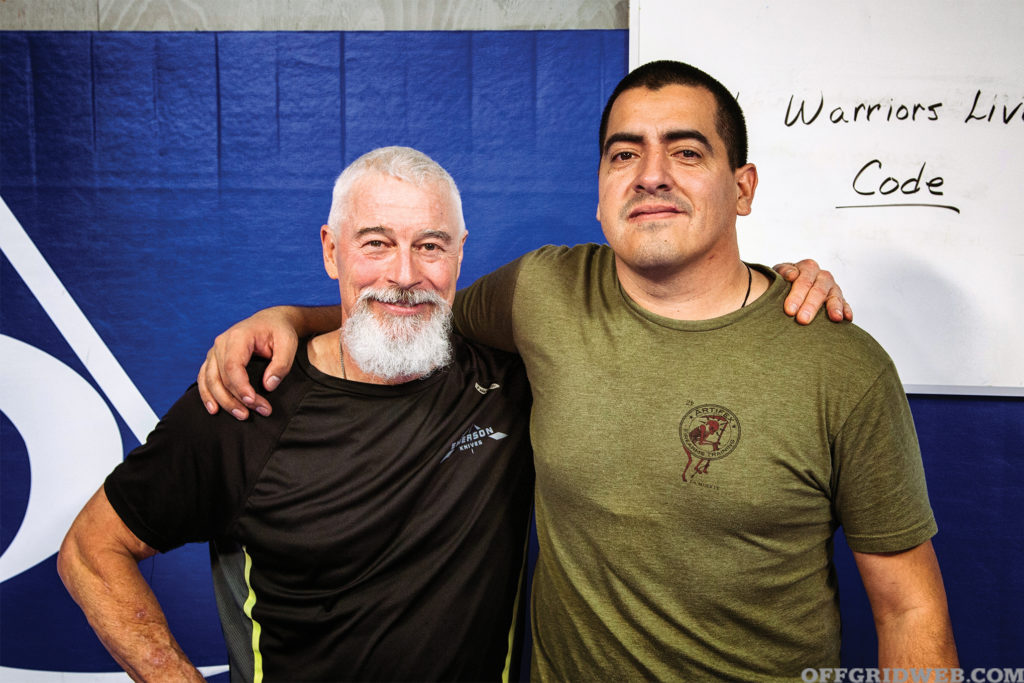
In order to prepare for these real-life threats, it’s critical to understand your adversary and understand your own strengths and weaknesses. If you become the victim of a violent crime someday, the education and training you’ve accumulated will help you be prepared to react without a second thought — as Ed Calderon puts it, “The worst planning is better than the best improvisation.”
For More:
 STAY SAFE: Download a Free copy of the OFFGRID Outbreak Issue
STAY SAFE: Download a Free copy of the OFFGRID Outbreak Issue
No Comments